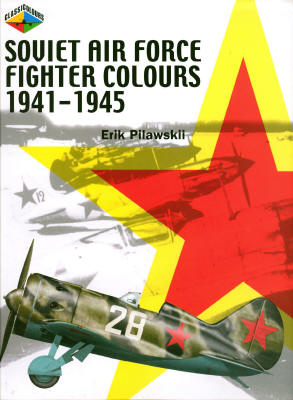|
Classic Publications |
|
Soviet Air Force Fighter Colours 1941-45 by Erik Pilawskii |
|
Reviewed By Clarence Wentzel, #11478 |
|
|
|
£35.00 + shipping from the publisher, $56.95
+ shipping from Specialty Press. This 224 page hardcover book should provide the modeler or aviation enthusiast with all of the information that they require related to the colors and camouflage schemes of Soviet fighter aircraft during the Great Patriotic War as it was called by the Soviets. The author was born in the US but has lived most of his life in Europe. He works in the IT field, is a pilot and has a love of aviation. Starting in 1987 he was able to gain access to many key wartime historical archives in the former Soviet Union. He has been able to work with various key personnel in developing a logical understanding of the various colors used by the different Soviet fighters during WW II. Many will recognize Erik’s name from the web site, “Modeling the Aircraft of the Soviet VVS 1930 – 1950”. Erik and Matt Bittner have been providing modelers with lots of great information on the Soviet VVS (Army Air Force) while Erik was working to prepare this book. We have been able to watch the changes to accepted levels of knowledge as new information has been discovered. In his preface, the author puts forth his opinion that the Second World War should have been entitled “The Great Germany-Soviet War” and that the vast majority of the German forces were met and defeated on the Eastern Front by the Soviets using their own resources. He feels that the Lend-Lease efforts of the US and England had no overall effect on the war and that the US and England could not have defeated Germany by themselves. I’m not sure that I can agree with this view of history but his personal opinion does not detract from this great reference document. The author has also included many stories from various personnel involved in the design and manufacture of Soviet aircraft. This makes the book entertaining reading as well as a key reference document. Typically, books on aircraft color schemes list a number of official documents from the governmental agency in charge of aircraft production and then go to show how the finished products were colored depending on which of the official documents were in effect at the time. With the Soviet aircraft, initial attempts to follow this line of reasoning regarding Soviet aircraft always left more questions than answers. The author has spent much time investigating the Soviet bureaucracy and found out that the key to the color schemes of Soviet aircraft lay within the individual Zavod or State Aircraft Factories. The factories used different paint colors and types of paints during the war period. The color of the aircraft would then depend on the factory where it was built and the date when it was built. Once the author was able to build the matrix of colors and factories and timeframes, he was able to review each major fighter type used by the soviet air force. He covers in order, the LaGG-3, La-5, La-5FN, La-7I-200, MiG-1, MiG-3, I-15, I-152, I-153, I-16, Yak-1, Yak-7, UTI-26, Yak-9 and Yak-3. Lots of color profiles, color schematics, photos, three-view drawings and detailed explanations are included. Chris Banyai-Riepl, one of the better artists in this area and the editor of “Internet Modeler”, produces the color profiles and line drawings. Over 300 photos are included; many published for the first time. The author seems to have made sure that there are photos of all of the aircraft that are featured in the color profiles. This is a real benefit to modelers. The color schematics trace the changes in the paint schemes and colors over various timeframes. When there are unusual camouflage patterns or local field modifications, the author does his best to explain how and why they happened and for the modeler, how to duplicate them. With regard to the colors themselves, the author has worked hard to come up with a defined list of the official designations for the colors and then references them to common factory and field names. Going further, the author references the colors as best he can to the FS color chart, to the Pantone system, to the Methuen Color Book and to the Munsell Color Match. When there are variation in the individual colors or changes with time, these are defined as best as they can be. Markings are covered only to the extent that they are included and explained in the color profiles, which is probably appropriate. There does not appear to be much official designation of markings except for the national insignia stars. In any case, modelers should be happy. A great amount of information on the design, development and production assignments of the different aircraft in included so that the aviation enthusiast will better understand the aircraft and the trials and tribulations that the engineers and pilots faced and overcame. In conclusion, I can recommend this book without hesitation to all modelers and aviation enthusiasts who are interested in Soviet fighter aircraft. It is a great reference that will be used in the shop while building models and also as an interesting history book. My thanks to Specialty Press for providing this review copy and to John Noack for letting me do this review. References; Specialty Press – 1-800-895-4585 or |
|
Information, images, and all
other items placed electronically on this site |
